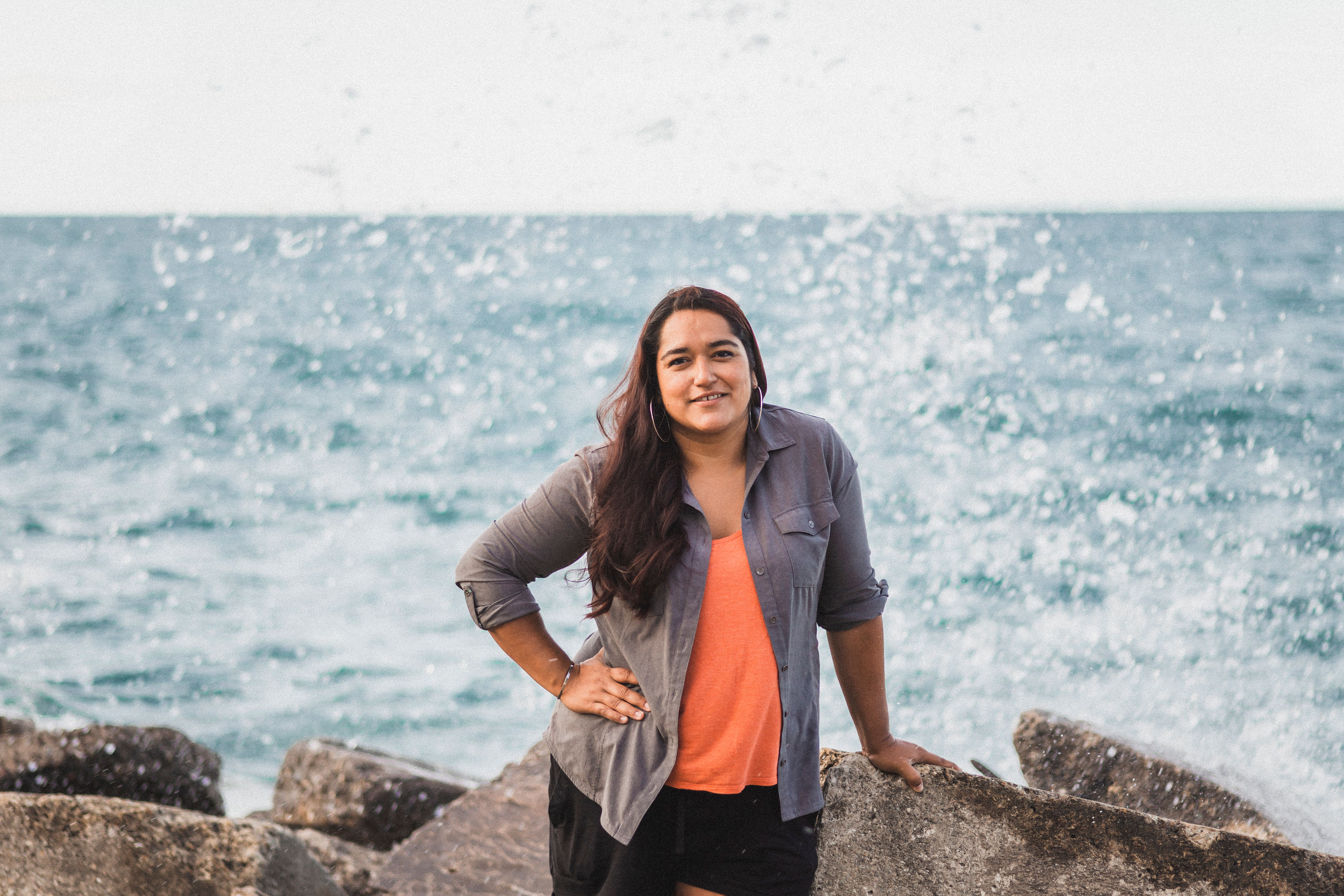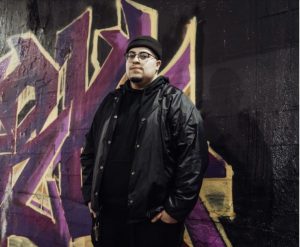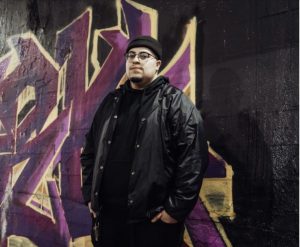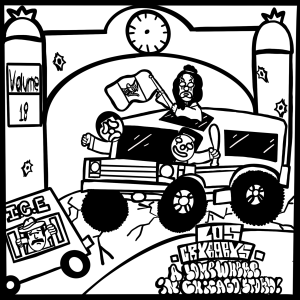Brighton Park, Back of the Yards, and McKinley Park are neighborhoods on the Southwest Side of Chicago that are bundled together so often that they are given a similar reputation and narrative by the media. It isn’t always a good one. Today these neighborhoods still face violence, poverty, and more recently, gentrification. I would like to challenge the idea that violence is the only thing these neighborhoods have to offer by shining a light on the creative minds that enrich them. In this series, “The Southwest Nest,” I hope to celebrate and recognize these artists and share with you their perspectives of the neighborhoods they either work in or call home.
Gloria Talamantes, known by her artist name, “Gloe,” takes on many roles, from being an editor for The GATE newspaper to practicing her art in the streets of Chicago as a graffiti artist and muralist. It is very typical to have seen a mural of hers in Chicago. Her street art can be found in many areas in Chicago like Little Village, Back of the Yards, and the downtown area. As the city changes with gentrification and the application of brown patches on graffiti, Gloria comes to the rescue with her talents. As Gloria and I converse, it is clear that her love for the community and art is what makes her glow.
This interview covers the span of a year. Part 1 of this interview was completed in late August of 2019 and Part 2 was completed in 2020.
Click for: English|Español

Part 1
Angelica Flores: Thank you so much for letting me interview you! You are one of the people who I was like, “Yeah, I just have to interview!” I want to start by asking, did you grow up in Back of the Yards or do you just work here now as an adult?
Gloria “Gloe” Talamantes: So I didn’t grow up here, but I grew up coming here a lot as a kid. I have family here. My uncle lives here so I grew up coming to his house but also I grew up going to Swap-O-Rama.
AF: So how did you get involved in the arts?
GT: I started getting involved in the arts first, one of my first experiences with art was obviously, you know, when we doodle as little kids. I was as young as maybe 4 or 5, that I can recall at least. And then when I started learning English in 3rd grade (I was still in bilingual classes), I wrote and illustrated my first book through the Young Chicago…
AF: Young Chicago Authors?
GT: It wasn’t YCA. It was something else for writers, Young Authors! They were blank books. They were all white so you would have to draw your cover and write your story and then illustrate it. That’s when I made my first connection with writing and visual art, and that was in 3rd grade. From then on, I think I was just on and off doodling and sketching and then later I started picking up the “Lowrider” magazines. I remember in my 6th, 7th, and 8th grade years I was really impacted by the graffiti that I was seeing in and around the neighborhood, specifically across the street because I would notice that it was different all the time. But also there was a lot of Old English style graffiti. It was all gang territory graffiti, kinda like gangs marking their territories or whatever, and so that always fascinated me. And then little by little I started learning about hip hop and hip hop culture. My sister was going to Curie High School when I was very young. She graduated in ‘89 and she kinda introduced me to a lot of the music genres that got me into hip hop. This was in the late 80’s for me, that’s when I started learning about hip hop. By the late 90’s I was already writing on the street and stuff. It wasn’t pretty (laughs).
AF: How did you get the nickname Gloe, or you use it as your artist name, right?
GT: Yes, so I had a number of people who called me Gloe. In addition to me using it as my artist name, I think it was just short for Gloria. But one of the people that really pushed that particular nickname, I remember, was my gym teacher in high school. And that’s just because he was really silly and he would try to find different words to rhyme Gloe with and he would keep going until he couldn’t figure out anything anymore. That was Mr. Meredith and also my division teacher at that time, Paul Joanes, both really pushed that name on me when I was in high school. But yeah, I think even before high school I had that name.
AF: Did you have a mentor growing up? Who are the people who you have looked up to?
GT: I feel like I’ve had so many mentors and they don’t necessarily know that they’re my mentors. Or maybe they do, but it’s not a set in stone type of thing. Growing up, I had a lot of great influences in both graffiti and in the art world, in the contemporary art world, with my writing, and in life. I think it’s a mixture of so many people. I feel like if I start naming people I’m gonna leave someone out and they’re gonna be so upset, so that’s why I don’t even want to name anyone. I think for me, I’d say, a lot of my mentorship really came from strangers in the street because I was always interested in the street culture, so I would talk to random strangers and/or neighbors. I had a lot of neighbors who I would talk to, but I also had friends within the hip hop culture.
One of the [people] I do want to mention is Isela Estrada. She was an instructor at the Southwest Youth Collaborative. At the time, it was the “University of Hip Hop” and everyone knew the organization. That’s where breakdancers, basically all of hip hop mixed together, would be in the same space. It was a really beautiful thing to experience during the time and she was always creating spaces for young women who were in the hip hop arts – whether they were breakdancers, graffiti writers, whatever it was, she was always creating a space there for us and to this day…I think there’s a lot that she helps me out with and she kinda walked me through stuff without her knowing necessarily.
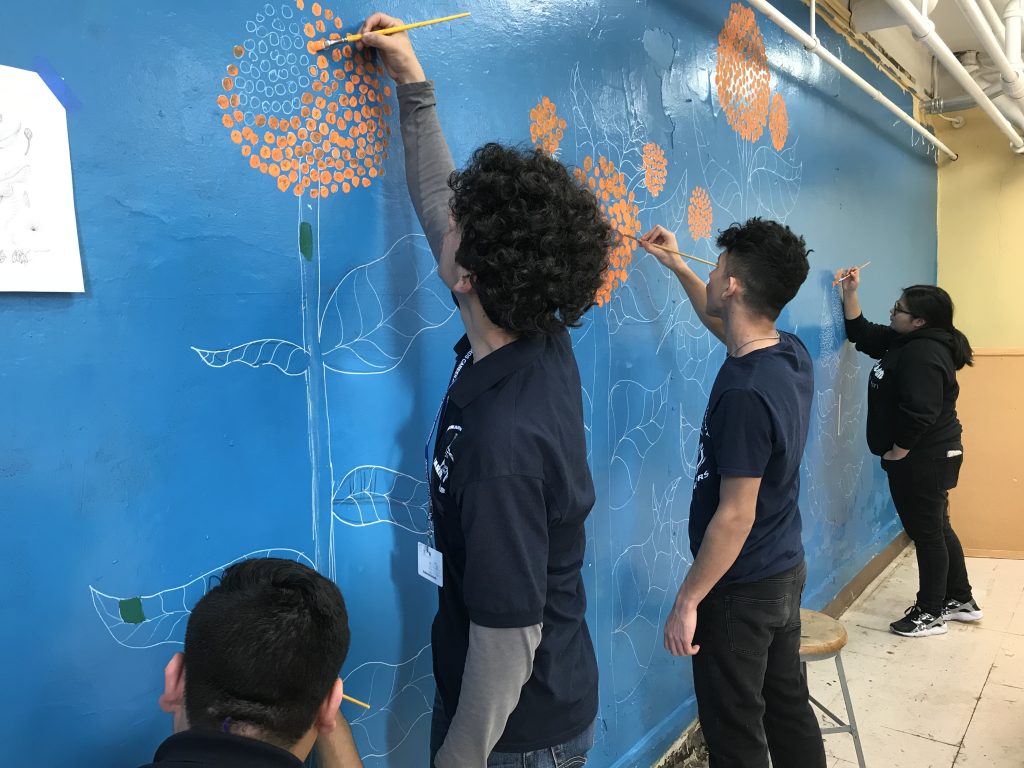
AF: Where is it located, the Southwest Youth Collaborative?
GT: It was located on 64th, on the 6400 block of Kedzie Avenue. I don’t know what neighborhood that is, honestly. My sister lived around there, too, so it was really easy to access for me. When I wasn’t by her house, I would just take the Kedzie bus, which was pretty annoying because you have to take 2 buses from Little Village to get there. Well, it stops by the Orange Line, but yeah, I’d say Isela Estrada is one of my big mentors and [someone] who has influenced me and offered me guidance.
I really enjoy mentorship from afar without really having to ask for mentorship, too. I think that we all tend to forget that we can have a mentorship that we decide to have without formally telling the person. I really, really enjoy seeing the growth of Krista Franklin and seeing how she has evolved so much from the time that I first met her. She is someone who I have always looked up to. We met in Minnesota, which was really interesting because she was in Chicago, so it’s not like we couldn’t have met here, but I thought it was really interesting to meet her over there. That was in the early 2000’s.
Delilah Salgado is someone else who I look up to. I really love the way that she honors community work and just her own artistic practice as a parent. I think it’s really hard. She has three kids and I only have one. I think that it’s very different. There’s definitely things I know I can’t do as an artist, or maybe I can do them, but there’s just a little more process to it than it would be if I didn’t have a child. But I’m just amazed by her dedication and determination to do her art while being a parent of three. Also, I want to mention Miguel Aguilar.
AF: You were quoted in an article by CBS2 about a mural registry that the city of Chicago established. Do you think it will actually help protect murals or do you have any doubts? What’s the process that artists need to do in order to register their murals?
GT: What I know so far on the process is that they tried really hard to make sure that it wasn’t too difficult for people to register their murals. If you’re in the DCASE database already as an artist, they will ask if you want your murals registered. And if DCASE is working with organizations, they will ask about their artists and if they want the murals registered and things like that. If you go on their website, you just fill out a one page form. You have to have permission from the owner to make sure that they want to give that permission to have it registered. From what I know, that is what they’re planning or I have no idea if it’s already happening. They’re planning to put an emblem of some sort, a sticker, so the Chicago graffiti blasters don’t whitewash, or erase it, or paint it brown.
AF: Do you think that would still protect it either way? Because it’s hard to place an emblem on a mural, isn’t it?
GT: Yeah that’s really difficult. That’s something I thought about because, you know, once you add something to a mural, whether it’s a placard, or anything, whether it’s painted or a sticker, you’ve already added to the mural so it changed the mural. Regardless, whether you get into the nitty gritty details of it, you changed the mural. I, personally, think that they should have rectified the system they already have with the graffiti blasters. It’s kinda like putting a band-aid on something that they’re not really tackling from the root, but that’s just my opinion.
AF: Yeah. I feel like it’s something like respect that people in general need to learn. To respect property and art. I think art is rooted in respect for some reason, I don’t know if that makes sense.
GT: Yeah it does. I definitely think there is an unspoken thing about respecting art and artists. Unfortunately, a lot of times, people don’t follow those unspoken guidelines of respect. I’ve had friends that had their murals and public artwork vandalized and/or painted over. I think it’s also a matter of accessibility and sometimes people who are painting on top of it or vandalizing are probably people who haven’t had arts education or some sort of outlet where they can learn a little bit of what that looks like.
AF: Yeah you’re right about that. I also did want to ask, what’s the difference between graffiti and mural making? I’m kind of ignorant to that visual arts side since I’m a writing person (giggles).
GT: For me, the difference between graffiti and mural making is that graffiti is, most of the time, based on letters and hip hop characters like B-boys and B-girls. Graffiti, for me at least, is disruption in public spaces visually, so it’s vandalism to a certain extent. Whereas mural making is more of a slower process and one that requires permission. There’s a different process to that, for me at least, I think about what I’m creating when I’m putting it up there. I’m thinking more of it as a permanent thing for a piece of artwork that has more longevity than graffiti. I can tell you, I’ve painted probably more than a thousand or two thousand times all over the states but people wouldn’t know that because it’s a process of buff, paint again, buff type of thing. And murals, not all of them as we have learned, are now permitted but they have a longer lifespan than a graffiti piecework. Also, murals are telling of history most of the time and murals allow you to— not that graffiti doesn’t, there are ways definitely — but I think for murals, it’s a lot easier to connect stories, to connect people to the imagery and to the concept of whatever the theme of the mural is. That’s what I think are the differences.

AF: That’s a really good response. I like how you said that graffiti is disruption and murals are more permission. I really like it. So do you also have any favorite works or favorite murals around the neighborhood?
GT: I do. I have a lot of favorites! Particularly on the South, or Southwest Side even?
AF: Yes, the Southwest.
GT: On the Southwest Side, one of my favorite murals is actually one that I feel like a lot of people miss and that’s why I think it’s one of my favorites, because I’ve grown to really love and respect the work. One artist didn’t work on it. I can’t remember exactly how many artists worked on it, but I know Hector Duarte painted this one alongside maybe one or two other artists. The one on the south end of Swap-O-Rama.
AF: Like on the building?
GT: So if you’re in the parking lot and facing the front part of Swap-O-Rama, it’s on the left. It’s the south exposed wall. That’s one of my favorite murals here in Back of the Yards. I think after that it has to be “the stream of life has no borders,” which is a mural that I luckily got a chance to help on. That one is by two Panamanian artists and it was led by them along with Chicago artists. It was a cultural exchange and I think that’s why I really love that mural. Because of the bonding that it created between two whole separate countries, merging two different worlds together and because of the comradery that we were able to bring together between two different cities in and out of the country. I wasn’t able to travel at the time to Panama, but they created one as well. The thing is, a lot of people don’t realize how many murals are in Back of the Yards and how much artmaking happens here. I think we’re an overlooked neighborhood in many senses.
One of my favorite murals [in the city] was whitewashed. It was on a church in Cabrini-Green. It was one of the earlier ones that I loved. That mural [“All of Mankind”] was by William Walker and for me that mural was beautiful. I only had a chance to see it in person because I used to take my son to school, so it just became a huge staple for me, but growing up I was able to pass by there and see it a lot of times. What I really loved about this one, is that I remember it since I was little, and my dad used to work all over the city. This is probably one of the first murals that I saw and really cultivated me. Chicago Public Art Group has really good documentation of that mural.
AF: Oh wait, so it’s not up anymore?
GT: No, so that area was getting gentrified and redeveloped so much. Someone purchased the church and the owners started painting over it.
AF: And I know a lot of your thoughts about gentrification already, is that one of the reasons why you started the Brown Wall project?
GT: It wasn’t. I think one of the biggest reasons for me was that visual arts and writing became a powerful way to use my voice. That’s how I learned how to use it. I think even now, I feel so weird being interviewed because I have a hard time switching my Spanish thoughts into English, so it’s really hard for me to process that stuff sometimes and it’s easier for me to have visual art as an outlet to share what I’m thinking, or share what I’m learning, or have learned of life. Also, the writing portion is a little different for me. When I am not feeling like picking up a spray can, or a brush, or paint, then I just write because that’s how I learned to cope with different things that I was going through in life.
But the reason why I started the Brown Wall project was because … when I started painting, there weren’t many girls painting at the time. I felt alone a lot of the time and so a lot of the things that I had to encounter, even just little things like conversations, they were so problematic. I just kinda kept to myself and even though I didn’t agree with what people were saying, I just kinda looked the other way and kept painting and doing my thing. It was so difficult for me, even if I spoke up for myself and said, “Hey, I’m gonna paint this wall” or “I wanna paint this wall,” at the time I was doing graffiti with a crew and they’d be like, “No, you still have to practice” or “Do this or do that,” and basically [saying], “Go out and prove yourself to us that you’re down and you’re really about this” or whatever, and so I was just like, “Fuck that, I’m just gonna get my own wall.”
That was one of the driving factors to [starting] the Brown Wall project. The other one was that during this same time, I was painting all over the city and I think I was in Ravenswood when this happened: I painted at night and the next morning I came like super early in the morning, like 6:30 in the morning, to take pictures of the fill-ins that I had done off the line right there and I actually saw that the graffiti blasters were painting my piece brown. My fill-in was being painted over and I just started thinking about what that meant and what does that look like in communities that I grew up in, to have brown all over. It’s something that I noticed really fast. I’d go up North to paint but I never really saw a lot of brown walls patched up and/or houses or things like that. When you come to the South and West Side you’ll even have brown patches on private homes, like actual homes, like greystones, and I was just like what the hell? How does the city even justify? Like, “Hey we’re gonna paint over this house even though we haven’t asked the owners, only because there’s graffiti on it or because somebody vandalized it,” and to me that was when I started noticing the differences between the city services and what was being allocated to what areas of the city and things like that. So I started thinking about that even further, “What are you erasing? What’s the erasure about?” And so for me, as a visual artist, the visual component, I was like, “You’re erasing people’s voices because that was my voice and if I paint a flower or if I paint my name, it doesn’t matter, that’s still my voice.” That’s some of the driving forces to founding the Brown wall project.
AF: And for the Brown Wall project, you paint over the brown patches?
GT: Typically, yeah. I try to scout walls in and around the Southwest Side, even though there are some projects that I’ve done up North. But mostly right now I’m focused on the Southwest Side because public space is so much, like we don’t even realize, walking down the street it affects you so much. I’m an advocate for mental health and I think our public space affects our mental health too and when we are seeing brown all over our neighborhood, what is that telling me? Like brown patches on cinder blocks and bricks and even the see-through glass. It makes me think, man, they don’t even care, they’re just like, “We’re gonna go all over it, we don’t care if it goes all over the window.”
AF: In a way, it feels like they’re the ones that are vandalizing, now that I think of it.
GT: Yeah, there’s just so many different elements to the graffiti blasting for me because you can erase things on surfaces, like outdoor surfaces. You can sandblast, pressure wash, paint in white or whatever, match the color, or brown, right? And I think it’s really interesting that a lot of the South and West Sides are usually browned out instead of sandblasted or power washed. I think that’s just been the driving force for me to keep questioning things and working on different projects. I was able to have more of a global conversation about erasure and what it means for communities of color by inviting international artists to paint when they come in from Mexico or wherever, so it’s just like another iteration of the project.
AF: What do you hope to bring to the neighborhood of Back of the Yards? Where you mainly work and you said that you were mainly focusing on the Southwest Side. So what do you hope to bring overall? Or like in 20 years, what would you like to have done?
GT: I don’t know if I can think as far [ahead] as in 20 years. There’s so much shit happening. It is so difficult to even think of tomorrow sometimes, but so far what I’ve been really intentional about is my time. If I’m working in this neighborhood, I’m very intentional about who I’m giving my time to and I want to make sure that other people get to see that, so that they can figure out for themselves what is impactful and what they can do to have an impact on others. What I’m hoping is that I stay grounded and rooted in a lot of the beliefs that I have in art and in life. I think for me, it’s really important to stay connected to the people who live here, who see the things that have been, firsthand, and to be there alongside them and be able to understand and relate to them, which is not really hard.
I’m constantly finding all the similarities between all these neighborhoods, it’s not just Back of the Yards, but one of the things that I am able to notice is that Little Village is very similar to the Back of the Yards. Where I was teaching at, at Richards, where you can visibly see the connections and disconnections between Black and Brown people. Richards is also placed in an interesting part of Back of the Yards, where a lot of people automatically believe that it’s Englewood, so it’s very close in proximity to Englewood there. So I always think about that. I always think about the similarities between these two completely different neighborhoods. Little Village and North Lawndale to me, represent the West Side, and Englewood and Back of the Yards represent the South Side so it’s really an interesting connection for me. I want to make sure that I’m also respectful of people in the neighborhood and that I share with them whatever it is that I have because I think a lot of times we’re in this rat race, thinking that we’re supposed to fend for ourselves and survival of the fittest, and to me that’s just not the way. It’s a very capitalistic way of thinking, without us even realizing, whether or not we have good or bad intentions. It’s a system that I think keeps on repeating itself and obviously, it hasn’t worked. So for me, it’s important to make sure that we’re not repeating the cycles that have kept things the same for such a long time. Also, I [try to] bring all the knowledge and skills that I know I can share with people in the community because, what am I gonna do with them once I die? Like my skills and my knowledge just die with me [so] I think it’s important to pass them on.

Part 2
AF: I know [the first part] our interview was back in August, but I’m curious to know how art (or your art) has been helping you during these times and is there anything else you would like to share with the audience?
GT: I believe that art has helped me with my anxiety. I grew extremely anxious when my neighborhood became like a warzone. I couldn’t sleep, I couldn’t eat, and I certainly couldn’t see myself making art during this time. I felt helpless. I remember breaking down when there was another prison-looking streetlight installed on my block’s sidewalk. Although it might not seem like a big deal to some and the illusion that lighting is “safe” is a thing. I know well that things like these are done without feedback or input from our community. Furthermore, we’ve been having terrible light and environmental pollution in Little Village in ways that are violent. So for me, it’s just like another violation to our collective quality of life.
We don’t talk enough about how things make us feel but these times have really opened me up in ways where I can share my thoughts and not continue repressing the way I feel to see my neighborhood hurt. I think this too is what art has helped me do over time.
During quarantine, I finished two pieces of artwork for the CTA that I started to work on pre-pandemic and I believe that a small part of the process in completing them was a form of my trauma response to everything that was happening. I utilized art-making to shift my focus on things that, as a child, I grew up knowing simply through observation. I went into finishing these pieces with the intentions of exercising my intuition and instinct. I am extremely lucky to have a great view of trees and so I envisioned myself working in the middle of a forest. Using my imagination was important during this time. I wanted to imagine a different world around me. Often, I waited to work on these pieces overnight in order to have silence and serene notions of my environment. I worked out of my patio. I wanted to create artwork that was soft and peaceful but also raw and urban.
I also worked with Honey Pot Performance Group (HPP). Forced to shift into doing remote collaborative work, it actually felt like magic to be able to connect on a deep level via Zoom. I didn’t expect that to happen the way it did. I am not typically a technology-based person when it comes to artmaking so I thought it would be a challenge but all the collaborating artists were amazing. My part of this collaboration was to creatively document the performances. I cried at times and other times I was able to feel joy, it was right on time as things were shifting so many different ways. The performances were in response to the then exhibition at the Chicago Cultural Center, “NKAME: A Retrospective of Cuban Printmaker Belkis Ayón” (1967-1999). If you got to see this exhibition in-person you are one lucky human. I am excited about our next steps with this collaboration. This work truly took me out of my physical space to help with some very much needed healing work too.
I live between Cook County Jail and the two trauma hospitals on Ogden Ave. The sirens never stopped. The National Guard presence in the neighborhood, police patrolling the streets, and the racially incited gang violence combined really drove in a level of restlessness and anxiety I had never in my life felt before. The dynamics of this formula were constant and consistent and truly made me hurt for the children in the neighborhood, others who were also going through witnessing everything I witnessed, and of course, myself. Collective grief was in full effect, and in many ways it still very much is.
I’ve always been extremely conscious about the impact my work could have in public settings so being in the middle of racially motivated gang violence that was inciting around me following the murder of George Floyd, some days, I couldn’t even create. I leaned on some of my family members as well as my chosen family to be better. I was internally sick and at times, that feeling still revisits me, it’s trauma.
I started thinking about murals that were going up in droves because businesses were scared of having their places broken into. But in that process I was also able to see how, in many cases, these businesses were also perpetuating racism and fear. Without passing judgement, I knew I couldn’t work on board ups in ways that weren’t thoughtful. Lydia, from the City of Chicago’s Department of Cultural Affairs and Special Events reached out about painting board-ups. The opportunity came at the perfect time, the artist block was in full effect, racially incited violence was taking over my neighborhood and it was all in divine timing. I’ve been painting board-ups with my students in Back of the Yards for years and in doing so, I intentionally add a historical, engaging, and educational approach. I knew I couldn’t retract from that. I couldn’t go backwards. I thought I wanted messages like, “Decolonize the Mural Movement,” but instead I asked myself, “What does that mean? How can you decolonize the mural movement in Chicago? How can I walk in that?” The answers have always been in the works and in process. I revisited my documentation and feedback that former students and community gave me throughout the years. I revisited Flowers for Healing (On Sixty!) and I checked in with myself constantly.
A group of women neighbors who are hood healers and I put together a mutual-aid group to keep our Black neighbors safe and as healthy as possible during these times. These amazing women wanted to learn how to spray paint and when I finally started processing and feeling better, things just started falling into place. I started painting the board ups with them and it was in itself healing and it didn’t mess with my artist integrity. Not only was I able to share my skills with others, like I normally do but I was able to use some of the funds for that project to give back to our communities through our mutual aid group as well as pay the women to help paint these board-ups. Sara Cortes, Laura Ramirez, and Angelica Robles were my fortitude and spray paint was our tool we used to start healing each other and our respective communities.
AF: Are there any updates with your work that you would like to share/ promote?
GT: I don’t have a date yet but Grand station on the CTA Blue Line is set to unveil a restoration project where the photographs of my art are going to be installed into light boxes. The pieces are honoring migrants who helped develop the Grand Ave Corridor but also, farm workers, grocery store workers, and other essential workers who during this time have truly made it possible for many of us to survive the pandemic thus far.
Currently, I am preparing to show the original pieces and a newer piece for Artist Run Chicago at the Hyde Park Art Center, where I have a collective artist residency with MM.
HPP continues to meet to plan for the month of November, when the performances and work we did will take a new iteration. I don’t have a lot of information but please follow HPP on their social media and if you feel inclined to go further give them some of your money. They are a blessing to the artistic landscape of this city.
I also am working on a site specific public art project in Back of the Yards and Little Village. I hope to have more information as we head into the Harvest Moon.
Featured Image: Gloe stands with her back to Lake Michigan with one hand on her hip and the other on one of the large beach rocks that surround her. Image credit: Vanessa Bly


Angelica Flores is a Mexican-American writer and Dominican University graduate. She enjoys working on English-Spanish translations and writes for The Gate Newspaper where she has reviewed books, films, and theater performances. She works for the Poetry Foundation and is the owner of the blog, The Macaron Raccoon.
